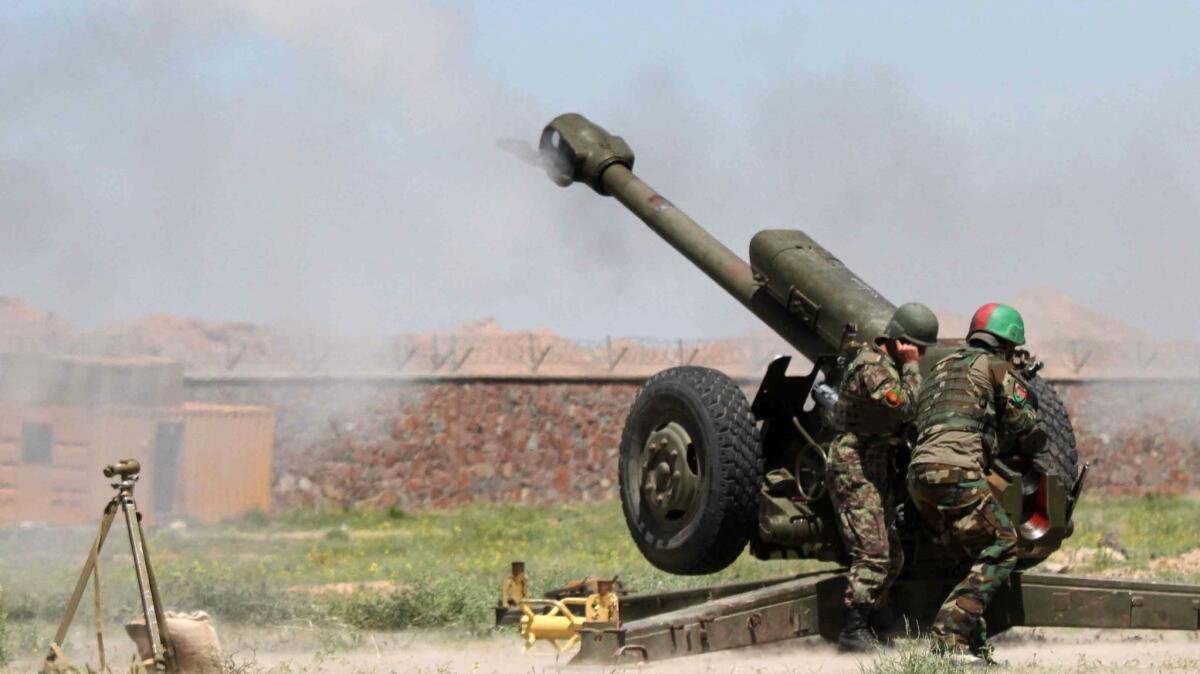Op-Ed: Brutal truths about our failure in Afghanistan are being drowned out by fake news

- Share via
It has become a journalistic game of sorts: Keeping a running tally of President Trump’s half-truths, untruths and outright lies. That game is not without entertainment value. Yet arguably at least as interesting and perhaps more instructive are the genuine truths that go essentially unnoticed, not only in the media, but also among elected officials and the general public.
A case in point: For years the Special Inspector for Afghanistan Reconstruction, a watchdog known by its initials — SIGAR — has sought to inform Congress and the American people about the nation’s progress (or lack thereof) in the Afghanistan war. Those efforts, in my estimation, qualify as heroic. They have also been largely ignored.
SIGAR’s 43rd quarterly report, published Tuesday, offers a veritable trove of facts, an example of what can easily be mined even in an era of fake news. Among its notable findings:
According to the most recent estimates, the Afghan government “controlled or influenced” no more than two-thirds of the total population. No available metric suggests that Afghan forces are winning the war, even with the support of some 14,000 U.S. troops and several thousand private contractors.
Today no real peace movement exists despite the fact that the United States is permanently at war.
Enemy-initiated attacks — an indicator of which side holds the tactical initiative — are increasing, up by 19% over the previous reporting period. An average of over 2,000 such attacks occur per month. Put simply, the bad guys act and the good guys react.
Total Afghan civilian casualties and civilian war-related deaths have increased by 5% and 11%, respectively, over the previous year. During that same period, casualties sustained by Afghan security forces jumped approximately 31%. The number of noncombatants killed or wounded by coalition airstrikes, most conducted by U.S. forces, is also on the rise.
The Afghan National Army is currently at only 83% of its authorized strength. Worse, its ranks are shrinking, calling into question the long-term sustainability of the force.
According to SIGAR, Afghan military morale and commitment remain problematic. For example, a U.S.-based program to train Afghan pilots was simply dissolved when over 40% of the student aviators went AWOL.
For years now, the United States has sought to reduce the prevalence of corruption in Afghanistan. Yet even today SIGAR describes corruption in the Afghan military as “pervasive” and notes that the government in Kabul “has not demonstrated that it is serious about combating corruption.”
Since 2002, the United States has invested $9 billion in counter-narcotics programs, to no avail. “Afghanistan remains the global leader in poppy cultivation,” the report says. While the 2018 Afghan opium crop did fall slightly from its all-time high the previous year, that decrease was primarily attributable to drought.
A legitimate Afghan economy barely exists. The nation’s total merchandise exports in 2018 fell well short of a billion dollars. At present, foreign grants account for approximately 70% of all public outlays, making the government in Kabul essentially a ward of the international community. Afghan democracy is likewise on life-support, with presidential elections originally scheduled for last April twice postponed “to implement voting-system reforms.”
Meanwhile, with most Afghans facing acute food insecurity, SIGAR reports that some households have resorted to selling their children or forcing them into childhood marriages in order to survive.
All in all, this makes for a dismal picture. For many months now, U.S. commanders in Kabul and senior officials in Washington have described the war in Afghanistan as “stalemated.” SIGAR’s latest report suggests that such a judgment may be excessively optimistic.
While not explicitly stated, SIGAR’s bottom line is this: Having over the course of nearly 18 years expended some $900 billion to create a secure, stable and democratic Afghanistan, the United States has failed. Indeed, those ambitious objectives have long since become implausible, with SIGAR noting that the current U.S. war aim is simply to promote “reconciliation between the government of Afghanistan and the Taliban.”
“Reconciliation” is a euphemism, a way to repackage failure as magnanimity. With only intermittent press attention, the Trump administration has been energetically courting the Taliban, hoping to negotiate a peace deal that will allow U.S. forces to withdraw once and for all. In this context, “peace” is also a euphemism. The exclusion of Afghan government representatives from those talks speaks volumes about whose interests are being served.
Enter the Fray: First takes on the news of the minute »
One day, perhaps sooner than later, the American war in Afghanistan will end, with Trump no doubt seizing the moment to nominate himself for a Nobel Peace Prize. At that point, SIGAR will close up shop, shipping its detailed and voluminous reports off to some archive to collect dust.
It’s a safe bet that Trump doesn’t care a whit about what will happen in Afghanistan after U.S. forces pull out. Yet the truth is that the majority of his countrymen don’t seem to care either — even as the war the United States initiated in 2001 goes on and on.
When I was a young man, members of a then-vigorous, if naive peace movement were known to remark, “Suppose they gave a war and nobody came?”
Today no real peace movement exists despite the fact that the United States is permanently at war. A different maxim pertains: Suppose we had wars and nobody bothered to notice?
Andrew J. Bacevich is a professor emeritus of history and international relations at Boston University.
More to Read
A cure for the common opinion
Get thought-provoking perspectives with our weekly newsletter.
You may occasionally receive promotional content from the Los Angeles Times.









